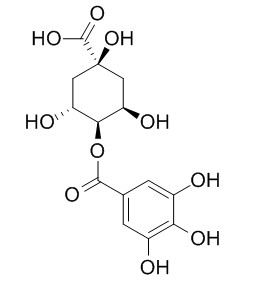4-Galloylquinic acid
4-Galloylquinic acid shows some antioxidative activity.
Inquire / Order:
manager@chemfaces.com
Technical Inquiries:
service@chemfaces.com
Tel:
+86-27-84237783
Fax:
+86-27-84254680
Address:
1 Building, No. 83, CheCheng Rd., Wuhan Economic and Technological Development Zone, Wuhan, Hubei 430056, PRC
Providing storage is as stated on the product vial and the vial is kept tightly sealed, the product can be stored for up to
24 months(2-8C).
Wherever possible, you should prepare and use solutions on the same day. However, if you need to make up stock solutions in advance, we recommend that you store the solution as aliquots in tightly sealed vials at -20C. Generally, these will be useable for up to two weeks. Before use, and prior to opening the vial we recommend that you allow your product to equilibrate to room temperature for at least 1 hour.
Need more advice on solubility, usage and handling? Please email to: service@chemfaces.com
The packaging of the product may have turned upside down during transportation, resulting in the natural compounds adhering to the neck or cap of the vial. take the vial out of its packaging and gently shake to let the compounds fall to the bottom of the vial. for liquid products, centrifuge at 200-500 RPM to gather the liquid at the bottom of the vial. try to avoid loss or contamination during handling.
Horticulture Research2022, uhac276.
Korean Journal of Pharmacognosy2019, 50(4):285-290
Toxins (Basel).2021, 13(12):898.
J Exp Bot.2016, 67(12):3777-88
Agriculture.2024, 69(3):140-148.
Med Sci Monit.2019, 25:9499-9508
J Biotechnol.2020, 318:10-19.
Molecules.2024, 29(24):5983.
Molecules.2020, 25(3):734
Molecules.2019, 25(1):E103
Related and Featured Products
European Food Research & Technology, 2004 , 218 (3) :253-261.
Antioxidant activity of Geranium macrorrhizum.[Reference:
WebLink]
The composition of radical-scavenging compounds from Geranium macrorrhizum leaves was analyzed and the antioxidative activities of various extracts was determined.
METHODS AND RESULTS:
Seven compounds, namely gallic acid, ellagic acid, 4-Galloylquinic acid, the flavonoid quercetin and three of its glycosides, quercetin-3--glucopyranoside, quercetin-3--galactopyranoside and quercetin-4--glucopyranoside were isolated and identified in the various fractions. The radical-scavenging activity of the isolated compounds was measured using DPPH and ABTS+ scavenging assays and compared with the activity of rosmarinic acid. Quercetin-3-glucopyranoside and quercetin-3-galactopyranoside showed the highest antioxidative capacities. Antioxidative activities of all plant fractions were assessed by model system tests (superoxide anion and hydrogen peroxide scavenging) and by oxidation tests (-carotene bleaching, peroxide value, UV absorbance and headspace-gas chromatography hexanal determination).
CONCLUSIONS:
The ethanol-butanol fraction of the plant possessed the highest activity in most of the tests.
J Agric Food Chem. 2007 Apr 18;55(8):2797-807.
Profiling and characterization by LC-MSn of the galloylquinic acids of green tea, tara tannin, and tannic acid.[Pubmed:
17381119]
Green tea, tara tannin, and tannic acid have been profiled for their contents of galloylquinic acids using LC-MS8.
METHODS AND RESULTS:
These procedures have provided evidence for the first observation of (i) 1-galloylquinic acid (11), 1,3,5-trigalloylquinic acid (22), 4-(digalloyl)quinic acid (28), 5-(digalloyl)quinic acid (29), and either 3-galloyl-5-(digalloyl)quinic acid (32) or 3-(digalloyl)-5-galloylquinic acid (33) from any source; (ii) 4-galloyl-5-(digalloyl)quinic acid (34), 5-galloyl-4-(digalloyl)quinic acid (35), 3-(digalloyl)-4,5-digalloylquinic acid (41), 4-(digalloyl)-3,5-digalloylquinic acid (40), 5-(digalloyl)-3,4-digalloylquinic acid (39), and 1,3,4-trigalloylquinic acid (21) from tara tannin; and (iii) 3-galloylquinic acid (12) and 4-Galloylquinic acid (14) from green tea. The first mass spectrometric fragmentation data are reported for galloylquinic acids containing between five and eight gallic acid residues. For each of these mass ranges at least two isomers based on the 1,3,4,5-tetragalloylquinic acid core (25) and at least three based on the 3,4,5-trigalloylquinic acid core (24) were observed.
CONCLUSIONS:
Methanolysis of tara tannin yielded methyl gallate, methyl digallate, and methyl trigallate, demonstrating that some of these galloylquinic acids contained at least one side chain of up to four galloyl residues.



